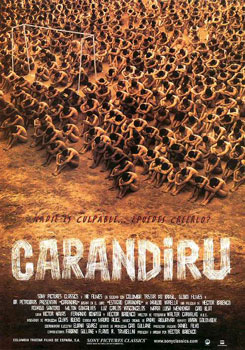- Carandiru (film)
Infobox Film
name = Carandiru

image_size =
caption = Theatre poster
director =Hector Babenco
producer = Hector BabencoOscar Kramer
writer = Hector Babenco
Fernando Bonassi
Victor Navas
Story:Dráuzio Varella
narrator =
starring = Luiz Carlos Vasconcelos
music =André Abujamra
cinematography =Walter Carvalho
editing =Mauro Alice
distributor =Sony Pictures Classics
released =Brazil :March 21 ,2003 United States :January 16 ,2003 Argentina :March 18 ,2004
runtime = 147 minutes
country = Brazil
Argentina
language = Portuguese
budget =
website = http://www.sonyclassics.com/carandiru/
amg_id = 1:286709
imdb_id = 0293007"Carandiru" (2003) is a
Brazil ian andArgentine film directed byHector Babenco . The picture is based on the book "Estação Carandiru" (English: "Carandiru Station") by Dr.Drauzio Varella , a physician andAIDS specialist. [imdb title| id=0293007|title=Carandiru.]Carandiru tells some of the stories that occurred in
Carandiru Penitentiary , which was the biggest prison inLatin America . The histories culminate with the 1992 massacre where 111 prisoners died, 102 killed by police. In2002 , one year before the release of the film, the Carandiru Penitentiary was closed.Plot
This episodic story is set in
São Paulo 's notoriousjail known as Carandiru, one of Latin America's largest and most violent prison systems.The doctor (Luiz Carlos Vasconcelos) is an
oncologist who arrives in the jail as a volunteer to test the prisoners forHIV infection.Seeing the disease, overcrowding, and rampant circulation of drugs, the doctor realizes much of the prison is controlled by the inmates. They decorate their cells and have an established pecking order. The strong inhabit messy individual suites, and the weak are jammed together, as many as sixteen sharing a 100-square-foot cell.
Several narratives develop in the film: the attempted murder of Peixeira (Milhem Cortaz), the solitary confinement of Chico (
Milton Gonçalves ), and the romance between Lady Di (Rodrigo Santoro ) and No Way (Gero Camilo).The doctor establishes a routine and comes to see the prisoners as survivors.
The picture ends with a violent prison riot that historically took place on
October 2 ,1992 . The repression of the riot became known as the Carandiru Massacre.Distribution
The film was first presented at the "II Panorama Internacional Coisa de Cinema" in
Brazil onMarch 21 ,2003 . It opened wide in Brazil onApril 11 ,2003 .Later the film was shown at the
Cannes Film Festival in France onMay 19 ,2003 .The picture was screened at various film festivals, including: the
Toronto Film Festival ,Canada ; the Hamburg Film Festival,Germany ; the Edda Film Festival,Ireland ; the Muestra Internacional de Cine,Mexico ; theSundance Film Festival ,USA ; theBangkok International Film Festival ,Thailand ; and others.In the
United States it opened on a limited basis onMay 14 ,2004 .Background
Director Hector Babenco shot the film on location in the actual penitentiary, and in neo-realist fashion he used a huge cast of novice actors - some of whom are former inmates. [ [http://www.bbc.co.uk/films/2004/04/08/carandiru_2004_review.shtml Russell, Jamie] . "
BBC ", film review,April 12 ,2004 .]Filming locations
The locations include: Carandiru Prison, São Paulo City, São Paulo, Brazil.Cast
* Luiz Carlos Vasconcelos as Physician
*Milton Gonçalves as Chico
* Ivan de Almeida as Ebony
* Ailton Graça as Majestade
* Maria Luisa Mendonça as Dalva
* Aida Leiner as Rosirene
*Rodrigo Santoro as Lady Di
*Rita Cadillac (Brazilian dancer) as Herself
* Gero Camilo as No Way
*Lázaro Ramos as Ezequiel
*Caio Blat as Deusdete
*Wagner Moura as Zico
* Milhem Cortaz as Peixeira
* Júlia Ianina as Francineide
* Sabrina Greve as Catarina
* Floriano Peixoto as Antônio Carlos
* Nelson Machado as CariocaCritical reception
Roger Ebert, critic of the "
Chicago Sun-Times ," appreciated the realism of the drama, and wrote, "Hector Babenco's "Carandiru" is a drama that adds a human dimension [a] ...Dantean vision. Shot on location inside a notorious prison in Sao Paolo, it shows 8,000 men jammed into space meant for 4,000, and enforcing their own laws in a place their society has abandoned. The film, based on life, climaxes with a 1992 police attack on the prison during which 111 inmates were killed... [the film] is a reminder that although Carandiru has disappeared, prison conditions in Brazil continue to be inhuman." [ [http://rogerebert.suntimes.com/apps/pbcs.dll/article?AID=/20040528/REVIEWS/405280301/1023 Ebert, Roger] . "Chicago sun-Times," film review,May 28 ,2004 . Last accessed:December 31 ,2007 .]Stephen Holden, film critic for "
The New York Times ", liked the film and its social message, and wrote, "Despite its confusion and the broadness of many of its strokes, the movie belongs to a Latin American tradition of heartfelt social realism in which the struggles of ordinary people assume a heroic dimension. The film is undeniably the work of an artist with the strength to gaze into the abyss and return, his humanity fortified." [ [http://movies2.nytimes.com/mem/movies/review.html?_r=1&title1=Carandiru%20%28Movie%29&title2=Carandiru%20%28Movie%29&reviewer=Stephen%20Holden&pdate=20040514&v_id=286709&oref=slogin Holden, Stephen] . "The New York Times," film review, "Inside a Notorious Prison, Fires of Rage and Regret,"May 14 ,2004 .]Critic Jamie Russell wrote, "Making his point without resorting to liberal hand-wringing, Babenco charts the climactic violence with steely detachment. Brutal, bloody, and far from brief, it's shocking enough to make us realise that this jailhouse hell really is no city of God." [ Russell, Jamie. Ibid.]
Awards
Wins
*Havana Film Festival : Audience Award; Glauber Rocha Award; House of the Americas Award; OCIC Award; Radio Havana Award; aúl Yelín Award; Special Jury Prize; all for Hector Babenco; 2003.
* Cinema Brazil: Cinema Brazil Grand Prize; Best Adapted Screenplay, Hector Babenco, Fernando Bonassi, and Victor Navas; Best Director, Hector Babenco; 2004.
*Cartagena Film Festival ,Colombia : Golden India Catalina; Best Film, Hector Babenco; 2004.
* ABC Cinematography Award, Brazil: ABC Trophy Feature Film; Best Sound, Romeu Quinto, Miriam Biderman, and Reilly Steele; 2004.References
Notes
External links
*
*
*
*
Wikimedia Foundation. 2010.
